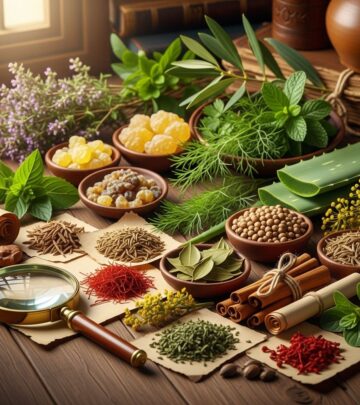25 Everyday Healing Herbs: Nature’s Best Remedies for Wellness
Plant allies woven into simple routines to nourish your body and restore inner balance.

Plants and herbs have been trusted for centuries as natural allies in healing, wellness, and everyday self-care. Today, science continues to confirm the immense value of botanical remedies for both prevention and relief from common ailments. Whether you’re new to herbal medicine or an experienced natural health enthusiast, these 25 healing herbs are safe, versatile, and simple to use in your daily life. Discover their key benefits, practical applications, and tips for making herbal healing part of your everyday wellness routine.
Why Use Healing Herbs?
Herbs contain powerful antioxidants, anti-inflammatory compounds, and other bioactive phytochemicals that can help to:
- Support immune defenses against colds, flu, and infections
- Reduce inflammation and oxidative stress in the body
- Promote better digestion and soothe stomach discomfort
- Calm the nervous system, improve mood and sleep
- Help manage blood sugar, cholesterol, and circulatory health
- Facilitate wound healing and soothe irritated skin
Many healing herbs can be brewed as teas, sprinkled into foods, taken as tinctures, or applied topically. Always consult your doctor before starting any herbal supplements, especially if you’re pregnant, nursing, have chronic health conditions, or take medications.
25 Healing Herbs You Can Use Every Day
1. Ginseng (Panax ginseng, Panax quinquefolius)
Key Benefits: Boosts energy, enhances mental performance, strengthens immunity, may lower blood sugar.
Ginseng root is renowned in both Asian and Western herbal traditions. It is considered an adaptogen, meaning it helps the body adapt to stress and restore balance. Ginseng extracts are linked with increased vitality, reduced fatigue, and support for healthy blood pressure. It may also help lower stress hormones and enhance brain function.
2. Garlic (Allium sativum)
Key Benefits: Antiviral, antibacterial, may support heart health and lower cholesterol.
Rich in sulfur compounds like allicin, garlic has long been prized as a natural antibiotic and immune booster. Modern studies show that regular garlic consumption can help reduce the risk of heart disease, lower blood pressure, and may even protect against some cancers. Crush or chop garlic and let it sit for a few minutes before using to maximize the formation of beneficial compounds.
3. Peppermint (Mentha × piperita)
Key Benefits: Soothes digestive upset, relieves headaches, decongests sinuses.
Peppermint leaf and oil are commonly used to calm nausea, ease bloating and cramps, and clear sinus congestion. Its natural menthol acts as a muscle relaxant, making it a popular natural remedy for tension headaches when applied topically as oil or balm.
4. Lavender (Lavandula angustifolia)
Key Benefits: Reduces anxiety and stress, promotes restful sleep, soothes burns and skin irritations.
Lavender is famous for its calming fragrance. Clinical research has shown lavender oil’s effectiveness in reducing nervous tension and promoting better sleep quality. Topically, lavender soothes sunburns, minor wounds, and mosquito bites.
5. Chamomile (Matricaria chamomilla, Chamaemelum nobile)
Key Benefits: Aids sleep, calms anxiety, relieves digestive discomfort, anti-inflammatory.
Chamomile flowers have gentle sedative properties, making them ideal in bedtime teas for insomnia and nervousness. They are also effective for relieving gas and soothing stomach pain. Chamomile compresses can be used to treat mild skin irritations.
6. Turmeric (Curcuma longa)
Key Benefits: Reduces inflammation, antioxidant, supports joint health, may reduce pain.
Curcumin, the main active compound in turmeric, is celebrated for its strong anti-inflammatory and antioxidant actions. Turmeric has shown positive effects for joint pain (including arthritis), metabolic syndrome, and general well-being. Adding black pepper enhances turmeric absorption.
7. Ginger (Zingiber officinale)
Key Benefits: Eases nausea, supports digestion, reduces pain and inflammation.
Ginger root is celebrated for its ability to soothe upset stomachs, reduce motion sickness, and alleviate menstrual pain. As a potent anti-inflammatory, it is also used to relieve sore joints and muscles.
8. Sage (Salvia officinalis)
Key Benefits: Improves memory, eases sore throats, helps with menopausal symptoms.
Sage leaf infusions have been traditionally used to treat mouth and throat inflammation. Research also suggests sage may enhance cognitive performance and reduce the frequency of hot flashes in menopause.
9. Echinacea (Echinacea purpurea)
Key Benefits: Supports the immune system, may shorten cold duration.
This North American wildflower is a classic herbal remedy for warding off colds and boosting immune defenses. Echinacea is often taken as a tea, tincture, or supplement at the start of a respiratory infection.
10. Lemon Balm (Melissa officinalis)
Key Benefits: Calms nerves, uplifts mood, helps with insomnia, relieves cold sores.
Lemon balm is a calming herb used to ease stress, support sleep, and even shorten the duration of herpes simplex outbreaks when applied topically. It’s gentle enough to be enjoyed as a relaxing tea during the day or before bed.
11. Cinnamon (Cinnamomum verum)
Key Benefits: Supports metabolic health, helps regulate blood sugar, anti-inflammatory.
Cinnamon bark is rich in antioxidants and helps modulate blood sugar levels. Sprinkled on foods or brewed as tea, cinnamon provides a warming spice that supports cardiovascular and metabolic function.
12. Parsley (Petroselinum crispum)
Key Benefits: Rich in vitamins and minerals, supports kidney health, freshens breath.
Parsley is much more than a garnish: it is a powerhouse of vitamin K, vitamin C, and folate. Traditionally used for kidney and bladder health, parsley has gentle diuretic properties and can help counter garlic breath.
13. Rosemary (Rosmarinus officinalis)
Key Benefits: Enhances memory, may protect brain health, antioxidant, antimicrobial.
With its invigorating scent, rosemary has been shown to improve concentration and cognitive performance. It is also used to flavor foods, stimulate digestion, and can support scalp circulation (used in hair rinses).
14. St. John’s Wort (Hypericum perforatum)
Key Benefits: Promotes emotional well-being, mild antidepressant effects, supports nerve health.
This bright yellow-flowered herb is widely researched as a natural therapy for mild to moderate depression. It’s available as extracts, teas, and capsules. Consult your doctor, as it may interact with many medications.
15. Thyme (Thymus vulgaris)
Key Benefits: Antibacterial, supports respiratory health, antioxidant.
Thyme is a culinary staple with potent antiseptic properties, working against microbes that cause coughs, sore throats, and respiratory congestion. It can be used as a gargle, tea, or even externally in natural cleaning solutions.
16. Holy Basil (Ocimum sanctum)
Key Benefits: Adaptogenic, helps balance stress, supports immunity, anti-inflammatory.
Holy basil (tulsi) is revered in Ayurveda as a “queen of herbs” for its adaptogenic properties, helping the body manage stress, regulate blood sugar, and bolster immune defenses. Drink it as a tea or add fresh leaves to salads.
17. Turmeric (Curcuma longa)
Key Benefits: Anti-inflammatory, antioxidant, promotes joint health.
This golden spice is noted for its ability to ease joint discomfort and curb systemic inflammation, making it a favorite for those with arthritis or inflammatory conditions.
18. Dandelion (Taraxacum officinale)
Key Benefits: Supports liver health, acts as a gentle diuretic, rich in vitamins.
All parts of the dandelion—root, leaves, and flowers—are used in herbal medicine. Dandelion helps stimulate digestion, detoxification, and acts as a natural diuretic, supporting kidney function.
19. Cayenne Pepper (Capsicum annuum)
Key Benefits: Boosts metabolism, relieves pain topically, supports cardiovascular health.
The heat in cayenne comes from capsaicin, which is also an active ingredient in many topical pain creams. Internally, cayenne can stimulate circulation and support vascular health.
20. Oregano (Origanum vulgare)
Key Benefits: Antimicrobial, supports immune function, antioxidant-rich.
Oregano oil is a strong traditional remedy for fighting infections. Its essential oil, carvacrol, is a powerful antifungal and antibacterial. Dried oregano is also a staple for flavor and health in Mediterranean cuisine.
21. Fennel (Foeniculum vulgare)
Key Benefits: Eases bloating, supports milk production in nursing mothers, relieves coughs.
Fennel seeds soothe upset stomachs, help relieve coughs, and can be chewed to freshen breath. Fennel tea is often used for colic in infants and indigestion in adults.
22. Licorice Root (Glycyrrhiza glabra)
Key Benefits: Soothes sore throats, supports adrenal health, mild anti-inflammatory.
Licorice root is often found in cough syrups and teas aimed at respiratory relief. It can support adrenal function and helps combat stress-induced fatigue. Note: Licorice should be used cautiously in those with high blood pressure.
23. Basil (Ocimum basilicum)
Key Benefits: Anti-inflammatory, antibacterial, supports stress response.
Basil provides a robust dose of antioxidants and can help calm stress and inflammation. It also gives culinary dishes a fresh, aromatic boost; add raw at the end of cooking to best preserve its therapeutic qualities.
24. Aloe Vera (Aloe barbadensis)
Key Benefits: Heals burns and wounds, soothes skin irritation, aids digestion.
Aloe gel is perhaps the most famous home remedy for minor burns, scrapes, and sun damage. Internally, aloe latex may act as a mild laxative but should be used only in small amounts.
25. Calendula (Calendula officinalis)
Key Benefits: Promotes skin healing, anti-inflammatory, soothes rashes and wounds.
Calendula’s vibrant flowers are commonly infused in ointments or oils for treating cuts, burns, eczema, and other skin irritations. As a tea, it can also support digestive and menstrual comfort.
How to Use Healing Herbs in Daily Life
These herbs can be integrated into your life through a variety of easy methods:
- Infusions & Teas: Brewed from dried or fresh leaves and flowers for daily well-being or targeted symptom relief.
- Food & Spice: Added to meals, salads, soups, and smoothies for both flavor and health.
- Tinctures & Extracts: Concentrated herbal solutions taken by drop or diluted in water.
- Ointments & Compresses: For topical application to soothe skin, speed healing, or provide local pain relief.
- Capsules or Tablets: Standardized herbal preparations for measured dosing.
Whenever possible, use fresh herbs to maximize their antioxidant content. Add delicate herbs at the end of cooking to preserve potency. When using dried herbs, store in airtight containers away from light and heat for best results.
Cooking with Healing Herbs
Many of these medicinal herbs are kitchen staples that boost both flavor and nutritional value:
- Stews and soups: thyme, rosemary, sage, parsley
- Salad dressings and dips: basil, cilantro, dill, parsley
- Infused oils and vinegars: oregano, rosemary, garlic
- Homemade teas: chamomile, peppermint, lemon balm, ginger
- Spice mixes: turmeric, cinnamon, cayenne, fennel
Table: Quick Benefits Reference for 25 Healing Herbs
| Herb | Main Benefit | Common Use |
|---|---|---|
| Ginseng | Energy, immunity | Tea, capsules |
| Garlic | Heart, immune | Raw, cooked |
| Peppermint | Digestion, headache | Tea, oil |
| Lavender | Calming, sleep | Oil, sachet |
| Chamomile | Sleep, digestive | Tea, compress |
| Turmeric | Anti-inflammatory | Spice, tea |
| Ginger | Nausea, pain | Tea, raw, cooked |
| Sage | Memory, sore throat | Tea, seasoning |
| Echinacea | Immunity | Tea, tincture |
| Lemon Balm | Stress, sleep | Tea, extract |
| Cinnamon | Blood sugar | Spice, tea |
| Parsley | Kidneys, vitamins | Raw, cooked |
| Rosemary | Focus, memory | Tea, cooking |
| St. John’s Wort | Mood, nerves | Capsules, tea |
| Thyme | Respiratory, antimicrobial | Tea, cooking |
| Holy Basil | Stress, immunity | Tea, fresh |
| Dandelion | Liver, digestion | Tea, salad |
| Cayenne | Metabolism, pain | Spice, topical |
| Oregano | Antimicrobial | Oil, seasoning |
| Fennel | Digestive, lactation | Seeds, tea |
| Licorice | Throat, adrenals | Tea, extract |
| Basil | Anti-inflammatory | Raw, fresh |
| Aloe Vera | Skin, digestion | Gel, juice |
| Calendula | Skin healing | Ointments, tea |
Frequently Asked Questions (FAQs)
Are culinary herbs safe for daily use?
Most culinary herbs such as basil, parsley, rosemary, thyme, and oregano are safe for regular use in modest culinary amounts. Medicinal doses or extracts of some herbs, such as licorice root or St. John’s wort, should be used with medical guidance.
What’s the best way to get the most benefit from fresh herbs?
Add delicate herbs just before serving to retain their flavor and antioxidants. For robust herbs like rosemary or thyme, add earlier during cooking for full flavor extraction.
Can I use these herbs if I’m on prescription medications?
Some herbs (notably St. John’s wort, licorice, and ginseng) can interact with medications. Always consult your healthcare provider before beginning any herbal remedy if you take prescription drugs.
Which herbs are the best for immune support?
Key immune-supporting herbs include echinacea, garlic, ginger, elderberry (not listed above but widely used), and holy basil. They can be used at the first signs of illness or as part of a daily wellness routine.
References & Further Reading
- Modern clinical and traditional herbal medicine studies
- Health and wellness research from global sources
- Expert insights from respected herbalists and integrative practitioners
Empower yourself with the wisdom of these 25 healing herbs to enhance your daily health, the natural way.
References
- https://draxe.com/nutrition/top-herbs-spices-healing/
- https://www.betterhealth.vic.gov.au/health/healthyliving/herbs
- https://aanmc.org/natural-remedies/herbal-remedies-for-natural-healing/
- https://www.urmc.rochester.edu/encyclopedia/content?contenttypeid=1&contentid=1169
- https://www.piedmont.org/living-real-change/11-herbs-and-spices-that-promote-wellness
- https://www.healthline.com/health/most-powerful-medicinal-plants
- https://www.youtube.com/watch?v=0MDYXjW_794
- https://pubmed.ncbi.nlm.nih.gov/17022438/
Read full bio of Sneha Tete











